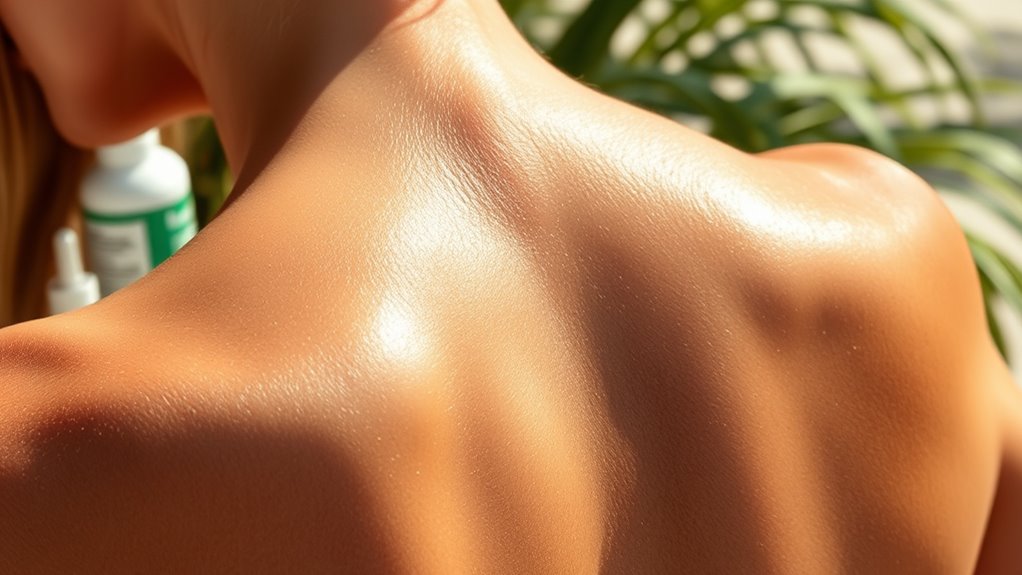To prepare your skin for summer tanning, start with thorough cleansing and gentle exfoliation at least a day before, focusing on rough areas like elbows and knees to guarantee smooth application. Protect your skin by applying broad-spectrum sunscreen, hydrate both inside and out, and eat nutrient-rich foods to boost melanin production. Time hair removal carefully, manage sun exposure safely, and use quality aftercare products. Keep your clothing loose and plan your tanning schedule wisely to achieve the best, even results.
Key Takeaways
- Exfoliate skin gently 24-48 hours before tanning to remove dead cells and promote an even, radiant tan.
- Cleanse thoroughly on the day of tanning, avoiding moisturizers or oils that can create barriers.
- Hydrate well internally and apply moisturizers afterward to keep skin supple and ready for tanning.
- Protect skin from UV damage by using broad-spectrum sunscreen and limiting sun exposure before tanning.
- Avoid hair removal treatments immediately prior to tanning to prevent irritation and ensure smooth skin.
Start With Proper Skin Cleansing and Exfoliation

Before you start tanning, it’s essential to begin with proper skin cleansing and exfoliation. Cleansing removes dirt, oil, and impurities, giving your skin a fresh surface for tanning products to work effectively. When your skin is clean, the tan applies more evenly, reducing patchiness caused by buildup. It also supports skin health by preventing clogged pores and breakouts that could interfere with your tan. Clean skin allows tanning lotions or sprays to adhere better, resulting in a more uniform color. Regular cleansing before tanning prepares your skin for exfoliation and hydration routines, making the whole process smoother. Additionally, maintaining skin health is crucial for achieving a beautiful, long-lasting tan. Proper cleansing and exfoliation also promote healthy skin cells, which are vital for an even and radiant tan. Incorporating moisturization into your skincare routine helps maintain skin elasticity and smoothness, further enhancing your tanning results. By starting with clean, refreshed skin, you set the foundation for a beautiful, long-lasting tan that looks even and radiant.
Protect Your Skin With the Right Sunscreen

Protecting your skin with the right sunscreen is essential for maintaining a safe and effective sun defense routine. Choose a broad-spectrum sunscreen that shields against both UVA and UVB rays, which help prevent sunburn, skin aging, and skin cancer. SPF 15 blocks about 93% of UVB rays, SPF 30 blocks 97%, and SPF 50 blocks 98%, but no sunscreen offers 100% protection. Remember, protection lasts about two hours, so reapply every two hours or immediately after swimming, sweating, or towel drying. Physical sunscreens with zinc oxide or titanium dioxide reflect UV radiation and are gentle on sensitive skin. Proper application is key—spread generously on all exposed areas and apply 15-30 minutes before sun exposure for maximum effectiveness. Additionally, incorporating water-resistant sunscreen can provide extra protection during aquatic activities or sweating. Being aware of sunscreen efficacy helps ensure you choose the best product for your needs. Understanding the importance of UV protection can further enhance your sun safety practices. Regularly checking sunscreen expiration dates ensures your protection remains effective over time. Advances in machine learning algorithms have also contributed to the development of more effective and personalized sun protection products.
Hydrate Adequately Inside and Out

Hydrating your skin both inside and out is essential for achieving a smooth, even, and healthy summer tan. When your skin is well-hydrated, it absorbs UV rays or tanning products more uniformly, reducing patchiness. Proper hydration also boosts skin elasticity, making your skin more resilient and helping to minimize signs of aging. Moisturized skin retains its glow longer by delaying cell turnover, extending your tan’s lifespan. Additionally, hydration decreases skin sensitivity, lowering the risk of irritation from UV rays or tanning products. Internally, drinking plenty of water supports cellular health, enhances skin flexibility, and promotes natural melanin production. Hydration technology plays a significant role in maintaining optimal skin moisture levels and overall health. Externally, applying moisturizer after showers or tanning sessions locks in moisture, keeps your skin supple, and protects against drying effects. Using a humidifier in your living space can also help maintain skin hydration levels, especially in dry or air-conditioned environments. Consistent hydration is your key to a radiant, even summer tan. Staying well-hydrated can also improve the overall appearance and health of your skin, making it more receptive to sun exposure. Incorporating proper skin care routines ensures your skin remains nourished and resilient throughout the season. Recognizing the importance of skin barrier health can further enhance your hydration efforts and overall skin vitality.
Maintain a Nutrient-Rich Diet for Better Tanning Results

Eating a nutrient-rich diet can substantially enhance your summer tanning results. Consuming foods high in carotenoids, like carrots, spinach, and mango, promotes natural melanin production, giving you a healthier, more vibrant glow over time. Beta-carotene converts to retinol, stimulating melanogenesis, while antioxidants like lycopene and zeaxanthin protect your skin from oxidative stress. Including vitamin E-rich seeds and nuts shields your skin from UV damage, supporting a more even tan. Trace elements such as copper boost melanin synthesis by activating key enzymes, and zinc and selenium aid skin repair and resilience. Essential fatty acids from fish and nuts improve skin elasticity, helping your tan last longer and look smoother. A varied, nutrient-dense diet not only enhances your tan but also promotes overall skin health. Additionally, incorporating toxin elimination through healthy foods can support your skin’s natural detox processes, further improving your tanning results. Consuming adequate hydration and including antioxidant-rich foods can also help protect your skin from sun damage and support a radiant glow.
Time Your Hair Removal to Avoid Skin Sensitivity

Timing your hair removal treatments carefully is essential to minimize skin sensitivity and guarantee safe, effective results. Avoid tanning or intense sun exposure for at least 2 to 4 weeks before treatments to lower melanin levels, reducing the risk of burns and pigmentation issues. If you’ve recently tanned or been sunburned, wait until your skin heals before proceeding, and consider a patch test two weeks after tanning to ensure safety. For laser procedures, inform your provider if you’re traveling to a hotter climate; they can advise on timing and sun protection. For other methods like waxing, avoid treatments immediately before tanning, as your skin becomes more sensitive and prone to irritation. Proper timing helps protect your skin and ensures better, more comfortable results. Incorporating Glycolic Acid into your skincare routine can also help improve skin texture and resilience, making your skin better prepared for summer tanning. Additionally, choosing protective styling methods can shield your skin from direct sun exposure during outdoor activities. Being aware of skin sensitivity and adjusting your routines accordingly can further enhance your tanning experience and skin health. Moreover, staying informed about digital literacy can help you better understand skin care innovations and safety tips for summer.
Prepare for Spray Tanning With Specific Pre-Treatment Steps

Properly preparing your skin before a spray tan guarantees an even, long-lasting result. Start by exfoliating at least one day before your appointment using gentle scrubs or mitts to remove dead skin cells. Pay special attention to elbows, knees, hands, feet, and the backs of ankles, ensuring these areas are smooth. After exfoliating, avoid applying any products to prevent barriers that could interfere with the tan. On the day of your session, shower to cleanse your skin, then skip moisturizers, oils, and lotions unless they’re specifically formulated for sunless tanning. Remove makeup and apply a clear coat to your nails to prevent staining. These steps create the ideal canvas for an even, beautiful spray tan that lasts. Incorporating proper skin preparation techniques from reputable sources can further enhance your tanning results. Additionally, choosing products with gentle exfoliating agents can help achieve an even finish.
Manage Sun Exposure to Maximize Safe Tanning

To maximize safe tanning, you need to manage your sun exposure wisely. Avoid the sun between 10 a.m. and 2 p.m., when UV rays are strongest. Always apply sunscreen with at least SPF 30 to shield against UVA and UVB rays, and reapply every two hours or after swimming or sweating. Wear UV-protective clothing to cover exposed skin and protect your eyes with sunglasses. Limit your total sun exposure to about one hour per session to reduce the risk of burns and skin damage. Remember to stay hydrated by drinking plenty of water, which helps keep your skin healthy and minimizes dehydration risks. Incorporating sound design techniques can further enhance your tanning experience and safeguard your skin’s health. By controlling your sun exposure, you can enjoy a beautiful, safe tan while protecting your skin’s health.
Use Aftercare Products to Sustain Your Tan and Keep Skin Healthy

Using aftercare products is essential for maintaining your tan and keeping your skin healthy. Hyaluronic acid-based products lock in moisture, helping your skin stay supple, hydrated, and elastic, which reduces the appearance of wrinkles and enhances your tan’s glow. Moisturizers like Cetaphil, E45, or Vaseline provide deep nourishment, preventing dryness and prolonging your spray tan. Tan extenders, such as Bondi Sands Everyday Gradual Tanning Milk, keep your skin moisturized and help maintain the color longer. Incorporate exfoliation tools like mitts or pre-tan exfoliators to remove dead skin cells before reapplying products. Regular use of hydrating, nourishing, and gentle exfoliating products will not only sustain your tan but also promote healthy, radiant skin throughout the summer.
Adjust Your Clothing and Accessories for Even Tanning

Adjusting your clothing and accessories is key to achieving an even, streak-free tan. Tan-through fabrics with a knit structure let UV rays penetrate while offering some protection against burns. They help reduce tan lines caused by traditional clothing, especially when made from special mesh fabrics engineered to transmit more sunlight. Choosing clothing with a low UPF, like 5, allows tanning while minimizing skin protection, but sunscreen is still essential underneath. Opt for loose-fitting, oversized garments to prevent creasing and ensure even exposure. Remove or cover accessories like watches, bracelets, or necklaces to avoid unwanted tan lines or shadows. Wide-brim hats and breathable wraps can protect sensitive areas without blocking sun exposure. Proper clothing adjustments help you tan evenly and safely, enhancing your summer glow.
Plan Your Tanning Schedule to Optimize Results

Planning your tanning schedule carefully guarantees you achieve a safe and even tan without risking skin damage. Limit your sessions to 1-3 times per week, depending on your skin type and goals. Always leave at least 24 hours between sessions to prevent overexposure. For building a base tan, avoid more than 72 hours between sessions since skin rejuvenates every 3 days. Adjust the frequency based on whether you’re building or maintaining your tan, and consider your skin type—some can handle more frequent exposure. Start with shorter sessions, gradually increasing duration as your skin adapts. Consistency is key, but listen to your skin’s signals. Following a well-planned schedule helps you get the best results while safeguarding your skin’s health.
Frequently Asked Questions
How Can I Prevent Uneven Tanning on Rough Areas Like Elbows and Knees?
To prevent uneven tanning on rough areas like elbows and knees, you should exfoliate these spots gently before applying tanner. Use a tanning mitt or sponge for precise application, and start with a small amount of product. Blending thoroughly and using tools like kabuki brushes helps avoid harsh lines. Also, apply a light layer and avoid over-darkening to guarantee an even, natural-looking tan on these textured areas.
What Are the Best Natural Supplements to Enhance Tanning Results?
When you’re aiming for a sun-kissed glow, natural supplements can be your secret allies. You’ll want to boost your intake of beta-carotene-rich foods like carrots and sweet potatoes, which help deepen your tan naturally. Add in vitamins E and C to protect your skin and support collagen. Plus, consider keratin hydrolysate and copper to enhance melanin production. Consistency and moderation will help you achieve a radiant, lasting tan safely.
How Often Should I Reapply Sunscreen During Extended Sun Exposure?
During extended sun exposure, you should reapply sunscreen every two hours to maintain protection. If you’re swimming, sweating, or towel drying, reapply more frequently—every 40 to 80 minutes for water-resistant formulas. Also, increase reapplication during high UV index days or when environmental factors like wind or sand can wear down your sunscreen. Remember to cover all exposed areas, including ears and feet, for maximum protection.
Can Certain Foods Improve the Longevity of My Tan?
Certain foods can definitely help your tan last longer. Foods rich in antioxidants like mangoes, watermelon, and tomatoes protect your skin from damage, while those high in vitamin A, such as sweet potatoes and carrots, promote skin health. Incorporate healthy fats from avocados and olive oil to support skin elasticity. Staying hydrated with melons and eating a balanced diet improves your skin’s condition, making your tan more durable and vibrant over time.
What Skincare Ingredients Should I Avoid Before Tanning to Prevent Irritation?
Your skin’s about to throw a tantrum if you don’t dodge certain ingredients! Stay away from retinol, AHAs, and exfoliants—they turn your skin into a red, inflamed battlefield when exposed to sun. Skip pore-clogging mineral oils, irritating preservatives, and harsh alcohols that strip moisture. If you don’t, your skin will protest with redness, irritation, and possibly a sunburn, ruining your perfect tan before it even begins!
Conclusion
Getting your skin ready for summer tanning isn’t just about looking good—it’s about protecting your skin too. Did you know that over 80% of skin aging comes from sun exposure? By following these steps, you’ll tan safely and enjoy a radiant glow all season long. Stay consistent with your skincare, hydration, and sun protection, and you’ll achieve beautiful, healthy results that last. So, start now and make this summer your best yet!









